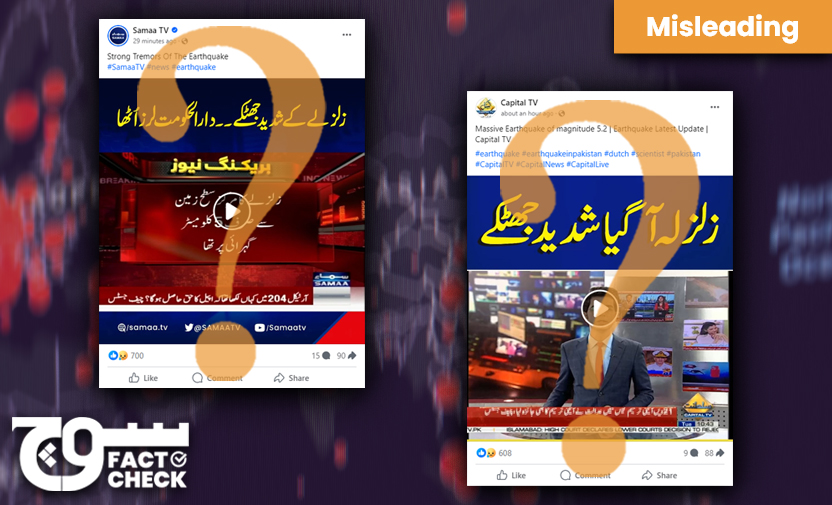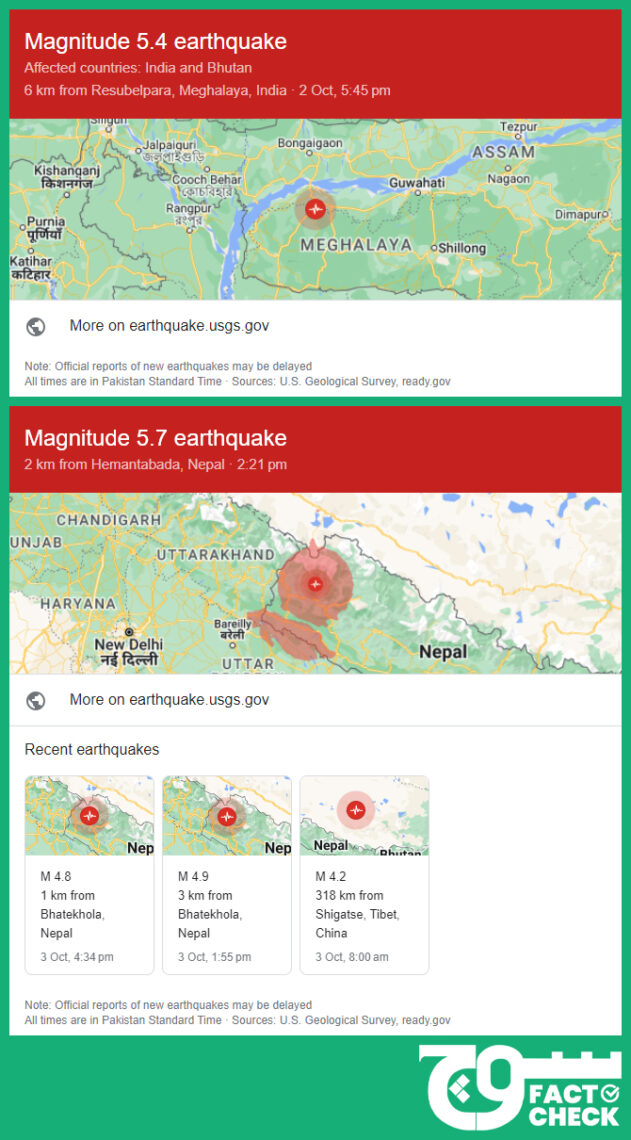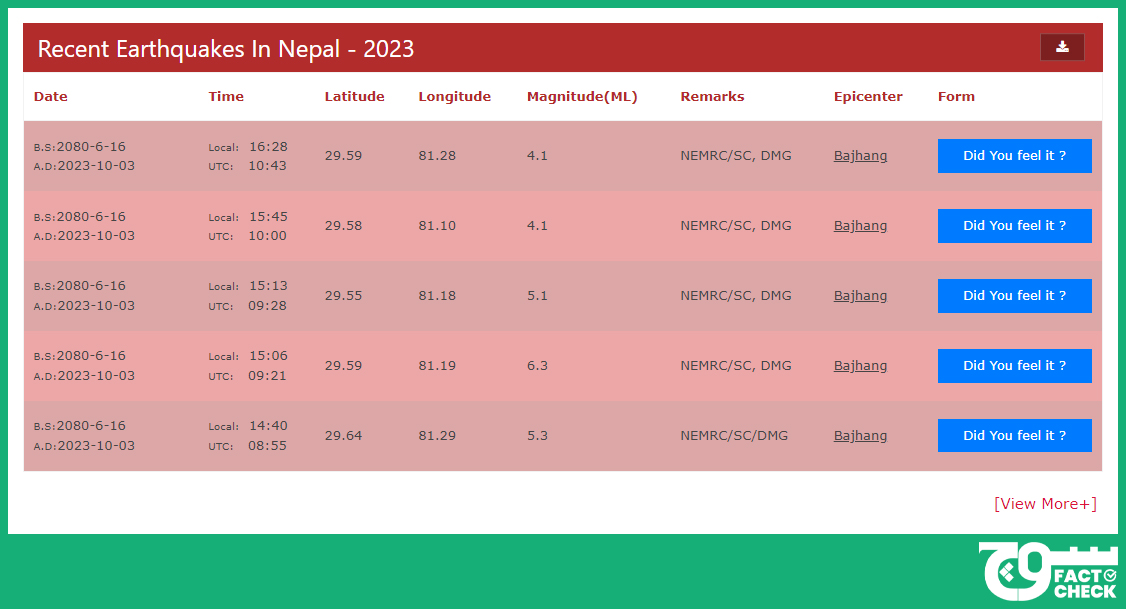
Claim: Capital TV and SAMAA TV claim an earthquake hit Pakistan, with people experiencing strong shocks.
Fact: Both news channels have posted a misleading video, which is actually about earthquakes that hit India on 2 October and Nepal on 3 October, respectively. The bulletins make no mention of Pakistan.
On 3 October 2023, Capital TV posted a video containing their 11 AM news bulletin, titled, “Massive Earthquake of magnitude 5.2 | Earthquake Latest Update | Capital TV.”
The thumbnail of the video — which has now gone viral on most social media platforms, including Facebook (archive), YouTube (archive), and Instagram (archive) — carries the following text:
“زلزلہ آ گیا شدید جھٹکے
[Strong shocks as earthquake hits]”
The hashtags accompanying the news bulletin were “#earthquake,” “#earthquakeinpakistan,” “#dutch,” “#scientist,” and “#pakistan.”

A couple of hours later, SAMAA TV also posted a similar video on Facebook (archive), Instagram (archive), and X (archive), formerly Twitter, with text in the thumbnail as follows:
“زلزلے کے شدید جھٹکے ۔۔ دار الحکومت لرز اُٹھا
[Capital shook by severe shocks as earthquake hits]”
“زلزلے کا مرکز سطح زمین سے صرف 5 کلومیٹر گہرائی پر تھا
[The epicentre of the earthquake was only 5 kilometres below the surface]”
The X post leads to this article (archive), which has the headline, “Magnitude 6.2 earthquake rattles Nepal, India.”
Quake ‘forecast’
It is important to note that Pakistani media was abuzz (archive) with news of an alleged earthquake forecast by Dutch scientist Frank Hoogerbeets — who rose to fame for predicting the 7.8-magnitude earthquake that hit Turkey and Syria (archive) on 6 February 2023 — that a quake would strike along the Chaman fault lines in the Balochistan province.
Hoogerbeets — who works as a researcher and software developer at the Solar System Geometry Survey (SSGEOS) — quoted (archive) his organisation’s post on X about a “Planetary & Seismic Update” for 29 September 2023, writing, “Planetary geometry is difficult to interpret with four conjunctions spread out over the next 10 days. As far as I can tell, 1-3 October will be more critical.”
He had not mentioned Chaman fault lines or Balochistan, let alone Pakistan, although the map shown in the video by SSGEOS only highlighted a small portion of the country. He later wrote (archive) that rumours appear “when we say that there is the possibility of a stronger earthquake” but that those “are false” since there “can be indicators” but “no certainty that it will happen”.
Finally, he referred to Pakistan in his tweet on 2 October, writing (archive) that his team “recorded atmospheric fluctuations that included parts of and near Pakistan” that would be “an indicator of an upcoming stronger tremor”.
On 30 September we recorded atmospheric fluctuations that included parts of and near Pakistan. This is correct. It can be an indicator of an upcoming stronger tremor (as was the case with Morocco). But we cannot say with certainty that it will happen. https://t.co/B6MtclMOpe
— Frank Hoogerbeets (@hogrbe) October 2, 2023
However, he again stated that there was no “certainty that it will happen”.
Fact or Fiction?
Listening to the video, it is clear that the bulletin is about a 5.4-magnitude earthquake that hit northeastern India, Bhutan, northern Bangladesh, and Tajikistan on 2 October 2023. This can be corroborated by reports in Indian media outlets such as NDTV and India Today.
Reports of the quake in Bangladesh and Tajikistan can be corroborated here (archive), here (archive), and here (archive).
The United States Geological Survey (USGS) (archive) also recorded the same, noting that the earthquake hit 24 kilometres south of Goalpara, India. The relevant map (archive) can be seen below:
The Google Alert for the earthquake says it struck at 6:15 PM (Indian time) on 2 October, six kilometres from Resubelpara in the Meghalaya state.

Therefore, we conclude that the Capital TV posts are missing context and can, therefore, mislead people. It is also an example of clickbait thumbnails, similar to those that we have investigated before, two of which are available here and here.
This is not the first time Capital TV has engaged in clickbait journalism; previously, it had claimed that the International Monetary Fund (IMF) issued a “Big Statement” over the protests against the higher electricity bills across Pakistan. Soch Fact Check debunked the claim and found it to be false.
On the other hand, the SAMAA TV news bulletin was, in fact, about two earthquakes — 6.3- and 5.3-magnitude on the Richter scale — that struck Nepal’s Bajhang district, according to Reuters (archive).
Nepal’s National Earthquake Monitoring & Research Center (NEMRC) recorded (archive) five quakes in succession in a two-hour period. The USGS also registered two of them — 4.9- and 5.7-magnitude on the Richter scale — here and here.

However, the claim that Nepal’s “capital shook” is misleading since the tremors were felt (archive) as far away as the Indian capital, New Delhi, which is towards the west of the quake’s epicentre, Bajhang; meanwhile, the capital Kathmandu is towards the east.
The claim that the epicentre was “only five kilometres below the surface” is also incorrect as, according to the USGS, the epicentres of the 4.9- and 5.7-magnitude quakes were 19.1 and 10.0 kilometres deep.
Kathmandu and the Dipayal Silgadhi municipality, the epicentre, are over 800 kilometres apart.
Virality
As of writing time, Soch Fact Check observed that the Facebook, YouTube, and Instagram posts of Capital TV were viewed more than 41,000 times, 165,000 times, and 300 times. The Facebook post received close to 150 shares.
Similarly, we observed that as of writing time, the Facebook and Instagram posts of SAMAA TV were viewed more than 43,000 and 73,100 times, respectively.
Conclusion: Capital TV has posted a clickbait video, which actually focuses on an earthquake that hit India on 2 October, whereas the SAMAA TV report is about the quakes that hit Nepal on 3 October. Neither bulletin makes any mention of Pakistan.
Background image in cover photo: Martin Sanchez
To submit an appeal on our fact-check, please send an email to appeals@sochfactcheck.com
